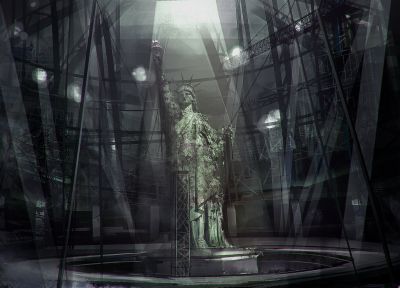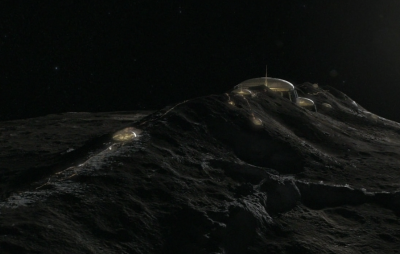Earth
General Information
System: Sol
Moon(s): Luna
Development level: Extremely High
Capital: N/A
Population (Planetside): 19,160,000,000 (est.)
Population (In Orbit): 987,950,000 (est.)
Earth (also called Terra, Gaia, or Sol III) is the third planet in orbit around the star Sol, and is the homeworld of humanity. Approximately 83% of its surface is covered in salt water, due to an amplified greenhouse effect melting the planet's polar ice caps several centuries ago. Originally home to millions of distinct species of flora and fauna, it is estimated that 94% of those species have gone extinct, but through the miracle of cloning dozens of new species that were previously extinct are being reintroduced every month.
The biosphere of Earth was severely polluted and ecologically ravaged towards the end of the 23rd century, and a runaway greenhouse effect was nearly achieved by the time all nonrenewable resources had been depleted. However, extensive private, corporate and government investment in reclamation programs, high efficiency renewable energy and sustainable development resulted in a reversing trend of pollution that has greatly improved living conditions on the surface.
Earth is the most densely populated planet in all of explored space, surpassing even the Skrellian homeworld's population by several billion. Earth is also the most developed planet in human space, with sprawling megalopolises, or "megacities." Several of these superdense metropolitan areas are built up in a tiered fashion. There is also a massive population of spacers living in orbit, and several tens of millions living on Luna, the natural satellite of Earth.
Geography
The size of Earth's landmasses are significantly smaller than they were in the centuries prior to the 22nd century. The melting of the polar ice caps caused massive rises in the overall sea level, and large stretches of land were submerged. Areas that are currently underwater include most of what used to be Sibera, the northern section of Eastern Europe, large portions of Canada, and approximately a third of Australia's landmass. Entire countries sank beneath the waves in South America, and the area of the United States that used to be the deep south no longer exists. A majority of the Pacific islands are also gone. With the melting of the ice caps, the rocky base layer of Antarctica was exposed.
Environment
The Earth's environment as of modern day is stabilizing at a steady rate. New growth forests that were sown several decades ago are now thriving on the outskirts of major metropolitan areas. The general air quality is now on par with that of the early 21st century, and the oceans have been subjected to extensive reclamation programs that have neutralized large portions of residual pollution. Artificially introduced fish stocks populate the depths, and cloned versions of extinct species have been reintroduced into the wilds.
This was not always the case. From the late 2100s to the late 2200s, Earth was approaching a critical mass in terms of pollution. Global temperatures had risen to the point that the planet was in the early stages of a runaway greenhouse effect, and air pollution blotted out the sun in some areas. Approximately 94% of all land species and 90% of all ocean species on Earth had gone extinct, and serious health issues due to the environment were especially rampant during this period. The world's rain forests were essentially gone, with only areas in Madagascar and the mountainous portions of South America retaining any significant degree of greenery.
Advances in technology and a massive shift in focus towards restorative and environmentalist policies eventually reversed the negative trend of Earth's environment by the early 2300s. Massive terraforming facilities recycled and neutralized pollutants and greenhouse gases in the atmosphere, and pumped out gas mixtures similar to Earth's atmosphere during the 2000s. Most cities were retrofitted to be sustainable, and DNA samples from various extinct species were used to reconstruct and clone them with current technology. Within the span of a century, a vast quantity of the effects of ecological and environmental devastation were nullified, reversed in some cases, and severely dampened at the very least.
Society
Humanity
Earth is the homeworld of humanity. Humans first evolved around 7 million years ago, but it wasn't until only 700 years ago that the human population skyrocketed due to the industrial revolution and the second green revolution. Since then, the population growth trend for humanity has been exponential, plateauing off slightly in the 21st century, but skyrocketing again with the emergence of planetary colonization. Approximately 50% of all humans live on Earth.
There was significant religious and ideological turmoil within humanity throughout its history, which often resulted in warfare and violence. This trend continued even past the creation of the Sol Alliance, and into the modern day. Terrorist groups still exist and rogue colonial governments will occasionally rebel, though the Sol Alliance has shown itself to be rather effective in terms of quashing rebellions and responding to terrorism.
Supranational Organizations
Since the creation of the Sol Alliance, warfare between the nation-states of Earth has become nonexistent. This is also partially attributed to the creation of supranational organizations to help the various countries manage their respective continents, as well as the Sol Alliance's peacekeeping and mediation duties. Most of the countries that existed around the 21st century are still in existence, though some have either been absorbed into their neighbors, while others were submerged under rising sea levels. Below is a roster of supranational organizations on Earth.
- North American Federation
- South American Alliance
- South African Collective
- Free African Nations
- Collective of Independent Caribbean States
- United Islamic Nations
- European Union
- Oceania
- Scandinavian Alliance
- Neo-Carolingian Federation
- Madagascar
- United Arab Emirates
- Pan-Asian Confederation
- New Russian Federation
Major Cities
Earth is the most densely populated planet in known space. The major metropolitan areas can stretch for hundreds of miles, and are referred to as "megacities". Megacities sometimes merge into each other, or extend over bodies of water. The best example of this are the twin artificial land bridges across the Persian Gulf that connect Dubai to the mainland portion of the UAE. Megacities can be home to billions of people, and as such can sometimes be tiered, such as the case with Beijing, Los Angeles, Dubai, Mumbai, New Delhi, New York City, Tokyo, Jerusalem, and London. Below is a roster of megacities on Earth.


Heritage Sites and Monuments
In the mid-20th century, an organization called UNESCO designated heritage sites, or areas and locations deemed culturally significant to humanity. Many significant sites were lost as sea levels rose to cover them over time, but significant architectures and monuments ended up being well preserved by their respective nations, and still exist into the modern day. Copies and reproductions of famous monuments exist on other planets, but the originals can still be found on Earth.
Luna

Star System: Sol
Parent Planet: Earth
Development level: Medium to Advanced; Interconnected Domed/Subterranean Cities.
Capital: Harmony City
Terrestrial Population (est.): 66,674,843
Spacer Population (est.): 162,981
Noteworthy places: Lunar University of Medical Science, Interstellar Aid Corps Headquarters
General Information
Luna is the only natural satellite of Earth. It is tidally locked to its parent and makes a complete revolution every 28 standard days. It formed when a rogue planetoid collided with Earth during the early stages of its formation. The moon came together from the resultant orbital debris. Luna was the first target of spacefaring humans as they pierced the outer layers of the atmosphere. It was largely ignored until the age of FTL travel and colonization, when small colonies were established, mostly as refueling and launching posts for re-entry craft.
Luna is something of a mishmash of human society. Early in the history of mankind's colonization of outer space, Luna was developed into an off-world shipyard where vessels would be constructed and launched, drastically cutting the cost due to the lower gravity. In modern times it has developed into a busy trade hub, where traders from across the galaxy come to offload goods before they make their final trip to Earth. It is also the home of Einstein Engines, who control nearly all the shipyards and construction sites on and orbiting Luna, with Nanotrasen having an unusually smaller stake.
Subterranean Cities
Initial exploration and colonization came with the discovery of vast subterranean lava tubes, two of which were as wide as 5km. Colonists and construction teams immediately set work in sealing and reinforcing these massive caverns, constructing subterranean towns which over the course of Luna's history developed into sprawling cities. There is a very large mining industry on Luna, with engineers and shaft miners being well paid and lucrative careers, because there are constant projects to expand and connect the subterranean cities with large and intricate mag-train subways. The trains travel at 507 km/h, allowing people to travel between even the farthest cities in mere minutes where regular travel on the surface would take many hours or even a full earth day.
Being far underground and connected to the surface via subway tunnels, escalators, and standard hallways, the Luna population is very well protected from asteroid strikes or other cosmic dangers. During solar storms or other such emergencies, emergency procedures are in place to evacuate the population underground. One famous example of this safety is during the New Phoenix disaster, where an asteroid was detected to impact in the city of New Phoenix only 7 minutes before impact. Most of the 12,000 residents were saved during the emergency evacuation, but the entire above-ground biodome was destroyed and the survivors left homeless. After this incident, all vital infrastructure (including gravity generators, atmospheric equipment, and government facilities) were moved underground.
Within the subterranean structures of lunar cities, much effort is made to maintain an illusion of space. While the majority of the lava tubes are are several kilometers in diameter, in the early days of lunar colonization, many colonists reported suffering from depression and panic attacks, as well as developing symptoms of claustrophobia. To combat this, open areas have been given powerful light sources designed to simulate natural sunlight, and residents of subterranean areas are prescribed vitamin D supplements.
Luna's Governor Kristen Anuja enjoys a moderate approval rating. She is supportive of Einstein Engines, and critical of Nanotrasen's growing involvement on Luna.
Locations of Note
Lunar University of Medical Science
The Lunar University of Medical Science has been a center for medical research in the Sol system for centuries. LUMSs first campus was founded by medical physician Dr. H.S. Cooper, who established the first and primary campus in Harmony City in the year 2190, making it 266 years old. It is one of the first medical universities on Luna, spurned on by a growing need for 'homegrown' medical experts after the constructions of the first biodomes were nearing completion. Internationally, LUMS ranks exceptionally well in the categories of Family Medicine, Neurosciences, Surgery, and is competitive with other peer universities in the disciplines of Anesthesiology, Orthopedics, Pediatrics, and Pharmacology. The current dean is L.Q. Anderson, PhD.
LUMS maintains several other campuses on Luna, along with 15 auxiliary campuses throughout the rest of Sol and the Inner-Colonies.
Admission to the School of Medicine and Health Sciences graduate program is highly competitive. For the MD class entering in 2452, a little more than 1,500 applicants were interviewed out of a total number of 14,700 applicants. Approximately 300 individuals were accepted to fill 177 spots. Curriculum revisions occur each year in response to student and faculty evaluations. 15 longstanding academic task forces continue to look at how best to develop longitudinal themes throughout the curriculum that will better prepare students for the challenges facing modern health care professionals and systems, including providing effective and equitable health care delivery in a variety of colonial environments.